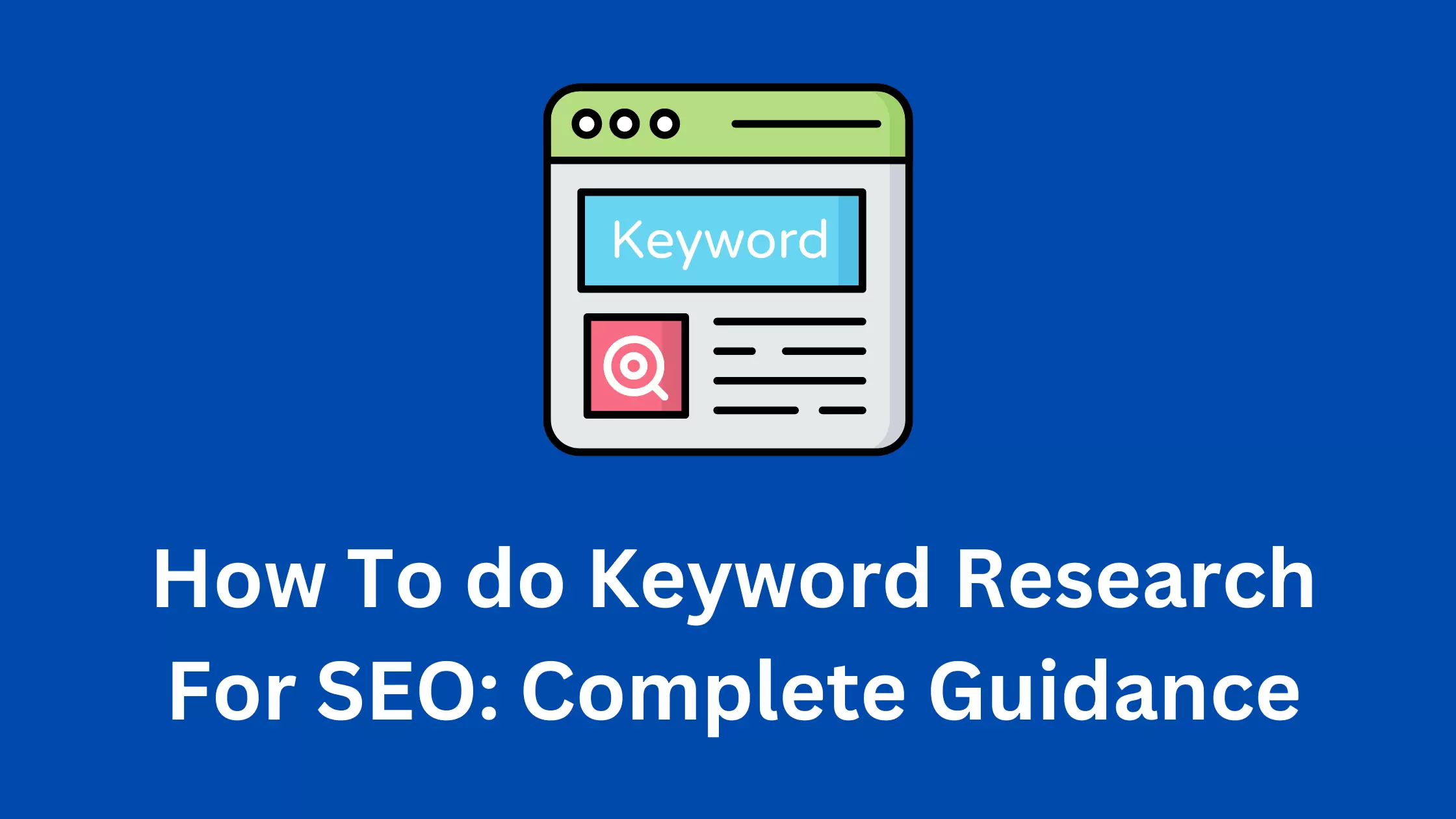Keywords, sometimes called SEO keywords, are terms and phrases used to establish and develop online content. It is an essential step in search engine optimization (SEO) that involves identifying the right keywords and phrases to target to improve your website’s ranking and attract relevant traffic. We will provide further complete guidance on Keyword Research for SEO.
You’ll learn the following things –
- Process of Keyword Research
- Understand the Business Niche
- Brainstorming “SEED” Keywords
- LSI Keywords based on their service location
- Keywords Tool Generators
- Categories in Search Content
- Keyword Golden Ratio
- Conclusion
Let’s get started!
1 – Step-by-step Process of Keyword Search –
Understanding the step-by-step process of keyword research can help you identify the best keywords to target for your website and improve your online visibility. This process typically involves researching the terms and phrases users enter into search engines for information on a particular topic. By identifying these keywords and incorporating them into your website’s content, you can improve your chances of ranking higher in search results and attracting more targeted traffic.
To conduct keyword research, you must use a combination of tools and techniques, including analyzing competitor websites, performing keyword brainstorming sessions, using keyword research tools like Google Keyword Planner, and analyzing search trends and volumes.
To conduct successful keyword research, the following are the key steps you need to take to identify the right keywords for your website.
Understand the Business niche.
Understanding your business niche is a crucial first step in finding the
keywords for your website’s search engine optimization (SEO) strategy. By clearly understanding the products or services you offer, your target audience, and the language they use to search for information related to your niche, you can identify the most relevant and valuable keywords to target.
Once you understand your business niche, you can brainstorm potential keywords and phrases that users might use to search for information about your products or services.
Brainstorming “SEED” Keywords
A seed keyword is a short-tail, usually with one or two words. Like short-tail keywords, seed keywords have high monthly search volumes and competition. While short-tail keywords may or may not have modifiers, seed keywords never have modifiers.
Brainstorming “seed” keywords is an essential first step in conducting keyword research for search engine optimization (SEO). Seed keywords are the main themes and topics relevant to your business or website, and they provide a starting point for identifying more specific and valuable keywords to target. Consider the main topics and themes relevant to your business or website. These include your products or services, your industry or market, or your target audience’s specific needs and pain points.
It’s important to remember that keyword research is an ongoing process. You should continually refine and update your keyword strategy as search trends and user behavior change. However, by starting with a solid foundation of seed keywords and using various tools and techniques to identify more specific and valuable keywords to target, you can improve your website’s search engine rankings, attract more relevant traffic, and ultimately drive more business to your website.
Find Out LSI keywords based on services and location
LSI (Latent Semantic Indexing) keywords are words and phrases semantically related to a piece of content’s primary keyword or topic. These words and phrases are not synonyms but are contextually relevant to the topic and provide additional meaning to the content.
The importance of LSI keywords lies in their ability to help search engines better understand the content of a webpage or article. By including relevant LSI keywords in your content, you can signal to search engines that your range is comprehensive and relevant to a particular topic, improving your chances of ranking higher in search results. With the Image shown below, we can understand things much better.
LSI keywords can also improve the user experience by providing more depth and context to the content. By incorporating LSI keywords, you can create a more natural and informative piece of content that answers specific questions related to your primary keyword.
Get Keyword Ideas with Tools –
A free tool provided by Google that helps website owners monitor and maintain their site’s presence in search results. It allows users to track website traffic, identify indexing issues, and optimize website performance by providing insights into search queries and technical errors. It is a crucial tool for SEO professionals and website owners who want to improve their search engine ranking. We can also do Keyword Research which shows Page queries on Google Search Console.
A powerful solution for businesses and individuals looking to increase their online visibility and grow website traffic. Ahrefs Webmaster Tools is a free tool offered by Ahrefs that allows website owners to monitor and improve their website’s search engine performance. It provides detailed insights into website traffic, backlinks, and technical issues, enabling users to optimize their website’s SEO and improve their search engine rankings.
Semrush –
SEMrush is a popular all-in-one digital marketing tool that offers a comprehensive suite of features for SEO, PPC, content marketing, and social media marketing. It gives users insights into their website’s performance, including keyword research, competitor analysis, and backlink monitoring. With over 40 different tools, SEMrush is essential for businesses and individuals looking to optimize their online presence and drive more website traffic.
Ubersuggest is a free keyword research tool that gives users insights into keyword search volume, competition, and other vital metrics for SEO and content marketing. It helps users find profitable long-tail keywords, analyze competitors’ strategies, and improve their website’s ranking in search engines. A simple and user-friendly tool that can be used by both beginners and experienced SEO professionals.
Spyfu –
A competitive intelligence tool for SEO and PPC. Spyfu is a competitive research tool that provides insights into competitors’ keywords, ad campaigns, and organic search rankings to help businesses improve their search engine marketing strategy.
Google Auto-Complete –
Autocomplete is a feature within Google Search that makes it faster to complete searches that you start to type. Our automated systems generate predictions that help people save time by allowing them to complete the search they already intended to do quickly.
Google Auto Suggest –
This feature provides search suggestions as users type their query into the search box. It uses machine learning algorithms and user search history to predict the user’s search intent and provide relevant and personalized suggestions.
Google Keyword Planner –
It is a free tool provided by Google Ads that allows users to research and analyze keywords for their advertising campaigns. It provides insights into keyword search volume, competition, and cost-per-click (CPC) data, which can help users choose the right keywords for their campaigns. Google Keyword Planner is a powerful tool for businesses looking to optimize their advertising budget and improve their ad performance.
Categories in Keyword Search Intent
What is Keyword Intent?
Keyword intent refers to why a person is searching for a particular keyword or phrase. It is the underlying motivation or purpose behind a search query. Understanding keyword intent is essential for businesses and marketers because it helps them create content that matches the needs of their target audience.
By understanding the intent behind a keyword, businesses can create relevant and helpful content for the searcher. This can improve the chances of the content being ranked higher in search results and increase the chances of conversion. Let’s see what the types of Keyword search intent are.
And following are Its Types –
Informational search intent keyword –
Informational search intent keywords are keywords that are used by people who are looking for information or answers to a question. These keywords are typically used when the searcher is in the research phase of the buying cycle and is looking for information to help them make a decision.
Examples of informational search intent keywords include phrases such as “how to, “what is, “tips for”, “guide to,” and “best practices.” For example, someone might search for “how to bake a cake” if they are looking for information on how to make a cake or “what is SEO” if they want to learn more about search engine optimization.
These are essential for businesses because they allow for attracting potential customers in the early stages of the buying process. By providing helpful and informative content that matches the searcher’s intent, businesses can establish themselves as trusted source of information and build brand awareness. Additionally, creating content around informational search intent keywords can help companies to attract organic traffic to their website and improve their search engine rankings.
Navigational search intent keyword –
Navigational search intent keywords are keywords that are used by people who are looking for a specific website or webpage. These keywords are typically used when the searcher knows
exactly what they are looking for and want to navigate directly to that page.
Examples of navigational search intent keywords include phrases such as “Facebook login,” “Amazon prime,” “Netflix account,” and “Google Maps.” These are all examples of searches where the user is looking for a specific website or page.
Navigational search intent keywords are essential for businesses because they indicate that the searcher is already familiar with the brand or website and is looking to access it directly. For example, someone searching for a “Facebook login” is likely a user trying to log in to their account. By optimizing for navigational search intent keywords, businesses can ensure that their website or brand is easily accessible to users who are already familiar with it.
Commercial search intent keyword –
Commercial search intent keywords are used by people looking to purchase or engage in a commercial transaction. These keywords are typically used when the searcher is in the consideration phase of the buying cycle and is actively looking for products or services to buy.
Examples of commercial search intent keywords include phrases such as “buy now,” “discount,” “coupon code,” “best price,” and “free shipping.” For example, someone might search for “best price on iPhone” if they are considering purchasing an iPhone or “free shipping code for Amazon” if they are looking for a discount.
Commercial search intent keywords are essential for businesses because they can attract potential customers actively considering a purchase. Companies can improve their chances of converting searchers into customers by optimizing for commercial search intent keywords. Additionally, commercial search intent keywords are often associated with higher purchase intent, meaning that users searching for these keywords are more likely to purchase or engage in a commercial transaction.
Transactional search intent keyword –
Transactional search intent keywords are keywords that are used by people who are looking to make a purchase or engage in some transaction. These keywords are typically used when the searcher is in the purchase phase of the buying cycle and is actively looking for products or services to buy.
Examples of transactional search intent keywords include phrases such as “buy,” “purchase,” “order,” “Subscribe,” “book now,” and “sign up.” For example, someone might search for “buy Nike shoes online” if they are ready to purchase a pair of Nike shoes or “subscribe to Netflix” if they want to sign up for a Netflix account.
Businesses can improve their chances of converting searchers into customers by optimizing for transactional search intent keywords. Transactional search intent keywords are essential for businesses because they indicate that the searcher is ready to purchase or engage in a transaction. Additionally, transactional search intent keywords are often associated with higher purchase intent, meaning that users searching for these keywords are more likely to make a purchase or engage in a transaction.
Question keywords –
Question keywords are keywords that are used by people who are looking for answers to specific questions. These keywords are typically used when the searcher seeks information or clarification on a particular topic.
Examples of question keywords include phrases such as “what is, “how to,” “why,” “who,” “when,” and “where.” For example, someone might search for “what is climate change” if they are looking for information on the topic, or “how to cook spaghetti” if they are looking for instructions on how to make spaghetti.
Question keywords are essential for businesses because they can attract potential customers seeking information or answers to their questions. By providing helpful and informative content that answers the searcher’s question, companies can establish themselves as trusted source of information and build brand awareness. Additionally, creating content around question keywords can help companies to attract organic traffic to their website and improve their search engine rankings.
Singular & Plural Keywords –
Singular and plural keywords refer to variations of the same keyword, either express or plural. For example, “shoe” is a particular keyword, while “shoes” is a plural keyword.
Search engines treat singular and plural keywords as separate entities and may return different search results for each variation. However, in some cases, search engines may recognize the relationship between singular and plural keywords and group them in search results.
Businesses need to consider both singular and plural keywords in their SEO strategies. For example, if a company sells shoes, they may want to optimize for both “shoe” and “shoes” keywords to capture traffic from users searching for either variation. Additionally, businesses should consider the context in which singular and plural keywords are used, as the search intent may differ between the two variations. For example, a user searching for “shoe” may be looking for information about a specific type of shoe, while a user searching for “shoes” may be looking for a broader range of shoe options.
Long & Short Tail Keywords –
Long tail keywords are specific and more detailed keyword phrases that are typically longer, consisting of three or more words. They are often more specific and targeted than short-tail keywords and are often used by people who are further along in the buying process and have a clear idea of what they are looking for. For example, “best running shoes for women with flat feet” is a long-tail keyword.
Short tail keywords, on the other hand, are broader and more general keyword phrases that consist of one or two words. They are often more competitive and difficult to rank for than long-tail keywords due to their broader nature. However, they also tend to have higher search volumes than long-tail keywords. For example, “running shoes” is a short-tail keyword.
Businesses must consider long-tail and short-tail keywords in their SEO strategies. While short-tail keywords may have higher search volumes, they are also more competitive, making it challenging to rank for them. Long tail keywords, on the other hand, may have lower search volumes but are often easier to rank for and may attract more qualified leads due to their specificity.
Keyword Sorting
Keyword sorting organizes and prioritizes keywords based on relevance, search volume, competition, and other factors. The goal of keyword sorting is to identify the most critical and relevant keywords for a specific website or business and prioritize them in order of importance.
There are several methods for keyword sorting, including manual sorting and using keyword research tools. In manual sorting, keywords are categorized based on their relevance to the business and the user’s intent. This involves analyzing the search intent behind each keyword and grouping them into categories based on their relevance to the company and its products or services.
Keyword research tools can also be used to sort and prioritize keywords based on their search volume, competition, and other factors. Here we will be discussing Search Volume & Keyword Difficulty.
Search volume –
Keyword search volume refers to the number of times a particular keyword or phrase is searched for on search engines like Google or Bing in a given period, usually monthly. It is an important metric used in keyword research, as it helps to determine a keyword’s popularity and potential value.
Search volume can be measured using keyword research tools such as Google Keyword Planner, SEMrush, Ahrefs, and Moz Keyword Explorer. These tools provide estimates of the monthly search volume for a given keyword or phrase, as well as related keywords and their search volumes.
However, it’s important to remember that search volume is not the only factor when selecting keywords.
Keyword Difficulty –
Keyword difficulty is a keyword research metric to measure the competition level for a particular keyword or phrase in search engine results pages (SERPs). It estimates how difficult it will be to rank for a specific keyword or phrase on search engines like Google or Bing.
It’s usually represented on a scale from 1 to 100, with higher scores indicating higher levels of competition. Keyword research tools such as SEMrush, Ahrefs, and Moz Keyword Explorer provide keyword difficulty scores as part of their analysis.
However, it’s important to remember that keyword difficulty is just one factor to consider, and relevance, search volume, and user intent should also be considered when selecting keywords.
Keyword Golden Ratio (KGR) is a keyword research strategy used to identify low-competition, long-tail keywords with a high potential for ranking on search engines. The KGR method divides the search results by the monthly search volume for a specific keyword or phrase.
Keyword Golden Ratio(KGR)-
The KGR formula is
KGR = Number of search results that have the keyword in the inline title / Monthly search volume (exact match) of the keyword
Inlinetitle/ Monthly Search Volume
According to the KGR strategy, a keyword with a KGR of 0.25 or less has a high potential for ranking on the first page of search results. This is because it indicates a low level of competition for that keyword.
For example, if a keyword has 240 monthly searches and 25 search results have the keyword in the title tag, the KGR would be 0.25 (25/100). This would be considered a good KGR score and a keyword with a good chance of ranking.
Niche websites and content creators often use the KGR method to identify low-competition, long-tail keywords with a high potential for ranking quickly. However, it’s essential to remember that the KGR method is just one tool in the keyword research toolbox and should not be the only factor considered when selecting keywords. Relevance, search volume, and user intent should also be considered to ensure that the chosen keywords are appropriate for the business and will attract the right kind of traffic to the website.
Conclusion
In conclusion, conducting thorough keyword research is essential to any successful SEO strategy. By identifying the right keywords, businesses can optimize their website content to rank higher on search engine results pages, attract the right traffic, and increase their visibility and reach online.
With the right tools and techniques, businesses can gain valuable insights into their target audience’s search behavior and preferences and create content that resonates with their needs and interests. Following the complete guidance outlined in this article, businesses can enhance their SEO efforts and maximize their online presence for increased traffic, leads, and conversions.
BestoSEO Solutions Pvt LTD is Digital Marketing Agency in Thane, Mumbai, serving customers all around the globe. We drive business growth with digital ideas, creativity, and ever-shifting trends toward technologies, channels, and platforms. Achieve over 200% growth through Facebook, Instagram, and Search Engine Marketing Strategies. Want to know more about us? Contact us Today or via mail – [email protected]







